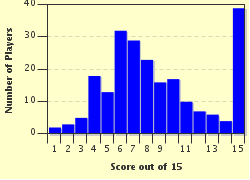Quiz Answer Key and Fun Facts
1. In all, how many twisters descended from the skies in the Super Outbreak?
2. Taking all the individual paths the tornadoes took, how far did the National Oceanic and Atmospheric Administration (NOAA) estimate the combined path extended?
3. Many of the twisters formed one after another in succession from the same individual thunderstorm cells. What are these known as?
4. About how many people died in the Super Outbreak?
5. Of the four listed towns hit by tornadoes during the Super Outbreak, which one had the greatest loss of life?
6. There were six confirmed F-5 tornadoes (the most destructive in the Fujita scale) during the Super Outbreak. One such twister, known as the Sayler Park tornado, did something not done since the infamous Tri-State killer storm of 1925. What did this storm do?
7. At one point during the Super Outbreak, weather forecasters in Indiana, swamped with numerous tornado sightings, did something that had not been done before. What was it?
8. Which Alabama town was hit twice during the Super Outbreak?
9. A number of tornado myths were brought into question following the Super Outbreak. One was that a tornado will not form at the convergence of major rivers. Was that myth busted?
10. Another myth about tornadoes is that they don't climb up or down steep hills. Was that myth busted during the Super Outbreak?
11. One area of the Super Outbreak that building engineers were able to focus on was the amount of damage certain structures received in the storms. What type of building seemed to get most of the attention from the twisters?
12. The one lone Canadian tornado in the Super Outbreak struck near what city?
13. One major outcome of the Super Outbreak was the rapid expansion of what service?
14. What was one of the biggest discoveries about tornadoes from the Super Outbreak?
15. One miraculous event in the Super Outbreak prompted the National Weather Service to issue a tornado warning for Louiville, Kentucky nearly 40 minutes before the storm hit the town. How was that achieved?
Source: Author
Oddball
This quiz was reviewed by FunTrivia editor
bloomsby before going online.
Any errors found in FunTrivia content are routinely corrected through our feedback system.

